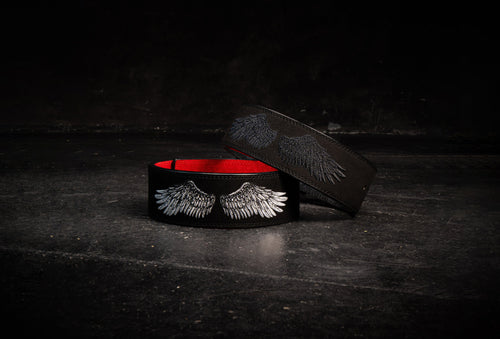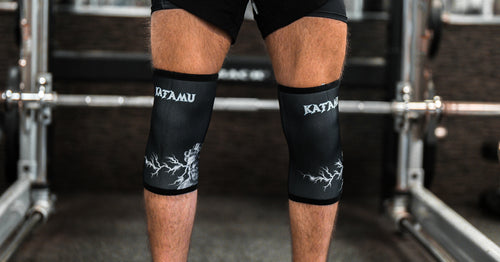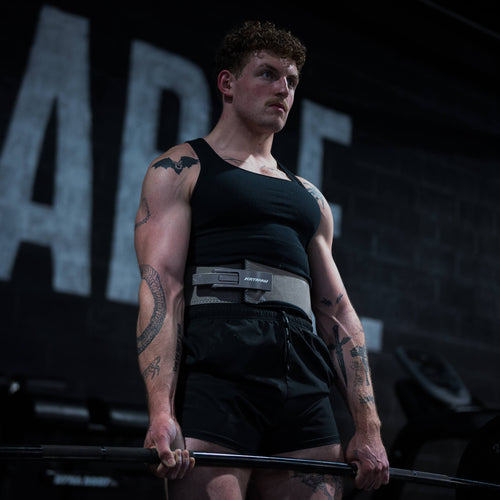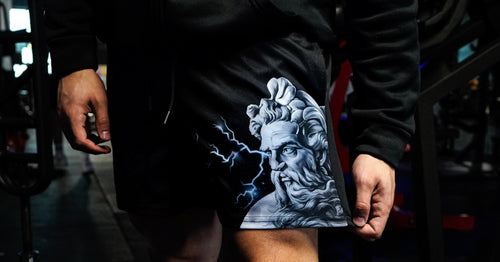Unlock your true powerlifting potential in 2025 with the right SBD belt, your ultimate ally for safety, stability, and record-breaking lifts. For any serious lifter aiming to reach new heights, the SBD belt stands out as a game-changer in performance and protection. This guide will walk you through expert tips, the latest selection advice, and advanced strategies to ensure you get the most from your SBD belt this year. Discover what makes the SBD belt unique, how to choose and size it perfectly, the best ways to train with it, and the essential care tips to keep it competition-ready. Ready to elevate your lifting journey? Let’s dive in.
Understanding the SBD Belt: Features and Benefits
Unlocking your best lifts in 2025 starts with the right equipment, and the sbd belt is at the forefront for serious powerlifters. If you want to reach the next level, understanding what makes the sbd belt unique and how it benefits your training is essential.
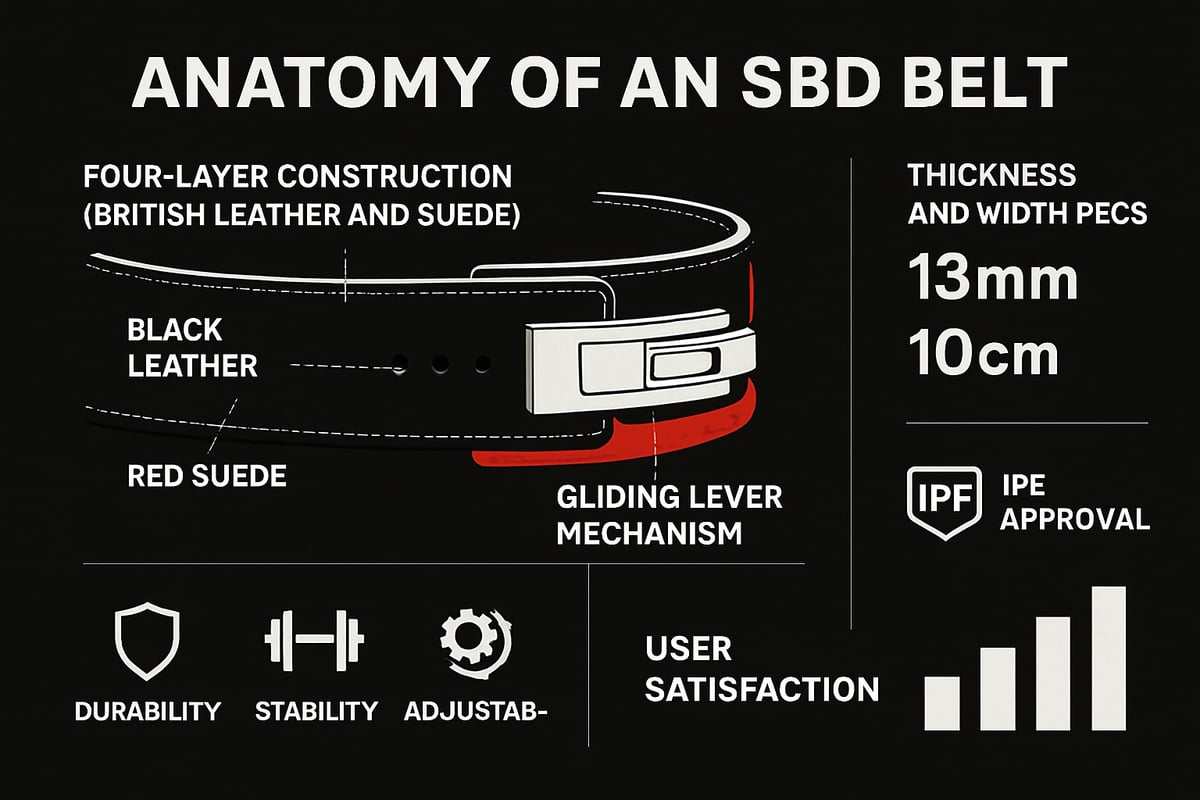
What Sets SBD Belts Apart
The sbd belt stands out in the powerlifting world due to its meticulously engineered features. At the core, you get a four-layer build using premium British leather and soft red suede, which delivers unmatched durability and support. This robust construction is paired with a patented gliding lever mechanism. It combines the micro-adjustability of a prong belt with the ease and tightness of a lever, making it efficient for quick changes during training or competition.
Here's a quick overview of the main features:
| Feature | Description |
|---|---|
| Construction | 4 layers: British leather & red suede |
| Lever Mechanism | Patented gliding lever for easy adjustment |
| Thickness | 13mm (maximum allowed for competition) |
| Width | 10cm (IPF approved) |
| Finish | Black oiled leather, red suede interior |
| Collaboration | Designed with elite athletes & coaches |
| Manufacturing | Made in Great Britain for quality control |
These specs are not just for show. The sbd belt is designed in partnership with elite athletes, coaches, and health experts, ensuring every detail meets the demands of competitive lifting. The black leather exterior and red suede lining add both style and function, while manufacturing in Great Britain guarantees strict quality standards.
Powerlifters in 2025 consistently praise the sbd belt as a "serious piece of kit" and highlight its "exquisite quality." According to recent reviews, it boasts a perfect 5.00 out of 5 rating based on 86 customer experiences as of September 2025. For a deeper dive into these innovative features, check out this SBD Belt Features and Benefits guide.
Key Benefits for Powerlifters
When you invest in an sbd belt, you are choosing a tool that delivers real-world performance. The primary benefit is enhanced core stability. By increasing intra-abdominal pressure, the sbd belt helps you lift heavier weights safely and with more confidence.
Other key benefits include:
- Consistent tightness and secure fit, whether you are in training or on the competition platform.
- Fast adjustability, which is perfect if you need to switch between exercises or adjust for body composition changes.
- Exceptional longevity, thanks to the premium materials and expert construction.
- Full IPF approval, making it a reliable choice for lifters at every level.
Many powerlifters report that the sbd belt provides the support they need for squats, deadlifts, and even heavy bench presses. The lever system allows for quick changes between sets, ensuring you never lose momentum. With proper care, the sbd belt will last for years, maintaining its support and comfort.
Choosing the sbd belt is not just about meeting competition standards. It is about maximizing your training potential and protecting your body from injury. As you push for new personal bests, the sbd belt remains your most trusted ally.
How to Choose the Right SBD Belt for Your Needs
Choosing the perfect sbd belt can make a world of difference in your powerlifting journey. With so many features, styles, and specs available, narrowing down your options can feel overwhelming. Let’s break down the process step by step so you can confidently select the sbd belt that suits your needs, goals, and style.
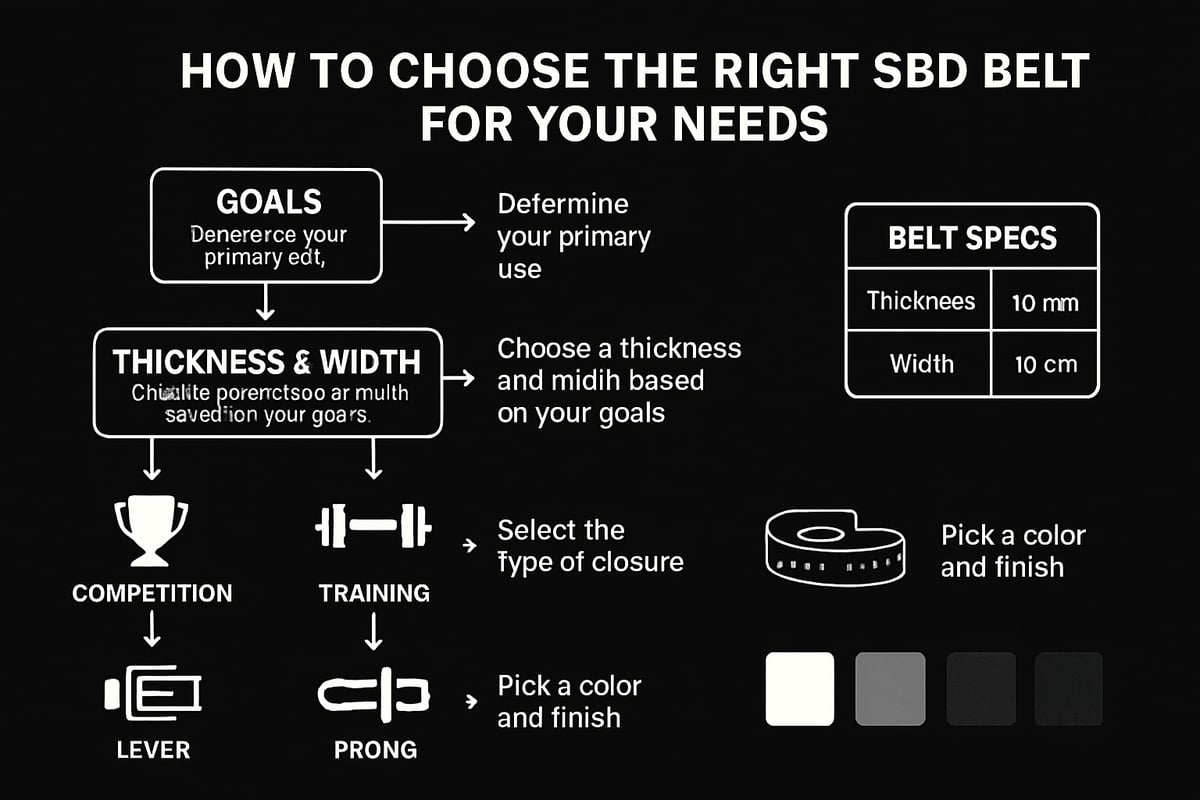
Step 1: Assess Your Powerlifting Goals
Before picking out an sbd belt, take a moment to consider what you want from your lifting experience. Are you planning to compete at the highest level, or do you train for personal bests and general strength? If competition is on your radar, IPF approval is essential, and the sbd belt is a popular choice among elite athletes.
Think about which lifts you need the most support for. Most lifters rely on their sbd belt during heavy squats and deadlifts, while some use it for bench press as well. If versatility matters, look for a belt that adapts easily between lifts and training styles.
- Competing: Prioritize IPF-approved belts for compliance.
- Recreational training: Comfort and adjustability might matter more.
- Versatility: Choose a belt that suits multiple lifts and training phases.
Step 2: Select the Appropriate Thickness and Width
The thickness and width of your sbd belt are crucial for both support and comfort. The standard sbd belt features a 13mm thickness and 10cm width, meeting IPF specs for competition. This combination delivers maximum core stability and intra-abdominal pressure.
If you are a newer lifter or prefer more comfort, you might want to compare these specs to thinner belts. Thinner options can be easier to break in and less restrictive, though they offer less support for maximal lifts.
| Belt Thickness | Support Level | Comfort Level | Best For |
|---|---|---|---|
| 13mm | Maximum | Moderate | Competitive lifters |
| 10mm or less | Moderate | High | Beginners, comfort |
Choosing the right sbd belt thickness is about balancing support with your personal preference and training goals.
Step 3: Understand Lever vs. Prong Mechanisms
The sbd belt stands out for its unique gliding lever, but it helps to understand how lever and prong mechanisms differ. Lever belts are favored for their ability to deliver a consistently tight fit with quick adjustments between sets. If you need to switch tension fast during a competition or heavy session, the sbd belt lever is a clear winner.
Prong belts, on the other hand, allow for more incremental adjustments. Some lifters find them more comfortable for longer training sessions or when body composition fluctuates. SBD’s patented gliding lever mechanism actually combines the best of both, offering both adjustability and secure closure.
- Lever: Fast, secure, perfect for competition singles.
- Prong: Fine-tuned adjustments, possibly more comfortable for some.
- SBD’s gliding lever: The innovation that blends both benefits in one sbd belt.
Step 4: Sizing and Fit
Getting the right fit is the backbone of sbd belt performance. Start by measuring your waist just above the navel, keeping your abs braced for accuracy. Avoid using your trouser size, as it will not reflect your true lifting measurement.
Aim to select a size where your measurement falls in the middle of the belt’s range. This leaves room for adjustments as your body changes through training seasons. If you are upgrading from another belt, use its tightest setting as a reference point. Some lifters recommend sizing up if you plan to wear layers or anticipate weight changes.
Need more sizing guidance? Check out this comprehensive Weightlifting Belt Size Guide for tips on accurate measuring and finding your ideal sbd belt fit.
Step 5: Style and Customization Options
Once you have your specs and fit sorted, it is time to think about style. The classic sbd belt comes in black with a red suede interior, but limited edition runs like Forge Grey or Orange are available for lifters who want to stand out.
If you compete, keep IPF regulations in mind, as only certain colors and designs are approved. For recreational lifters, feel free to get creative and pick a sbd belt that matches your personality or gym gear.
- Standard black/red: Timeless, IPF-approved.
- Limited editions: Unique colors, often in high demand.
- Customization: Choose the look that motivates you most.
Selecting a sbd belt is about more than numbers and specs. It is about finding the right blend of performance, comfort, and style to support your powerlifting ambitions.
Sizing and Setup: Getting the Perfect Fit
Finding the right fit for your sbd belt is the foundation for safe, effective powerlifting. A well-fitted belt supports your lifts, ensures comfort, and maximizes stability for years to come. Let’s break down the steps to measuring, setting up, and wearing your sbd belt like a pro.
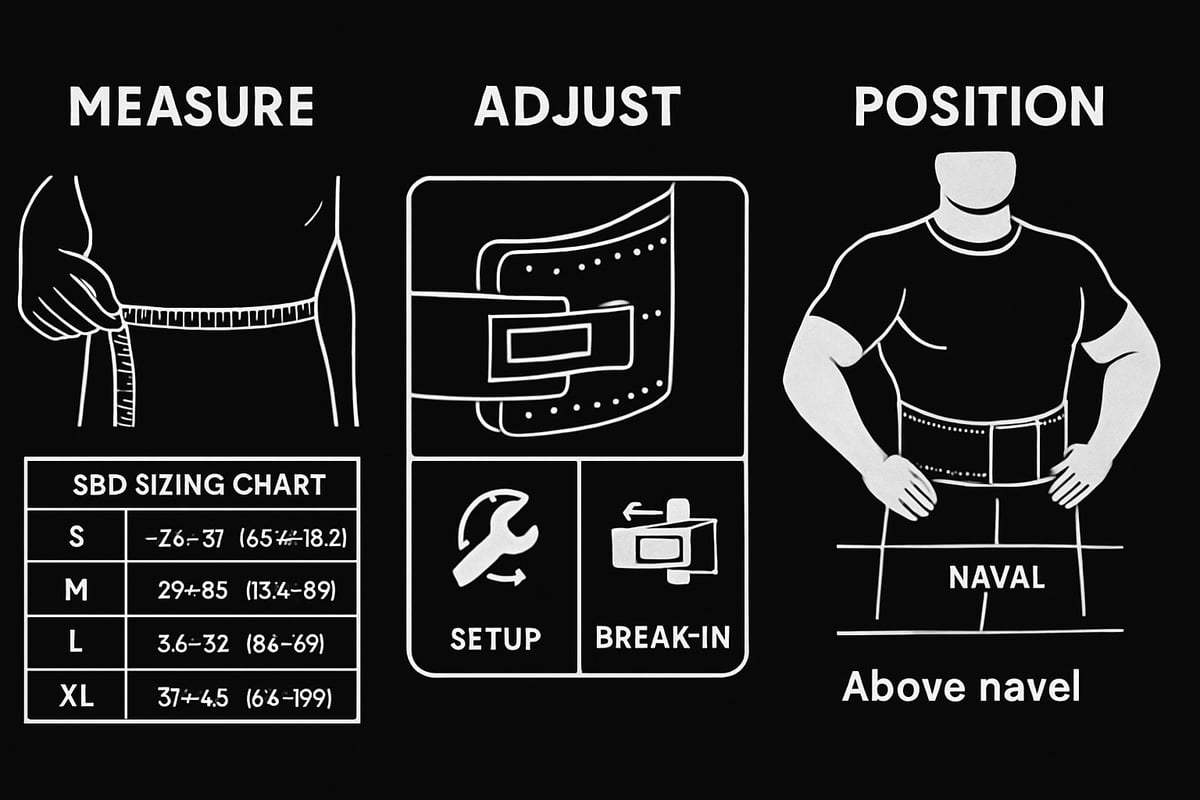
Measuring and Selecting Your Size
Accurate measurement is the first step to unlocking the benefits of your sbd belt. Never rely on your trouser size. Instead, use a flexible tape to measure around your waist where the belt will sit—usually just above your navel with your abs braced.
Here’s a quick reference for sbd belt sizing:
| Size | Waist Range (cm) |
|---|---|
| XS | 57.5 – 70 |
| S | 70 – 80 |
| M | 80 – 90 |
| L | 90 – 100 |
| XL | 100 – 110 |
| 2XL | 110 – 120 |
| 3XL | 120 – 130 |
| 4XL | 130 – 140 |
| 5XL | 140 – 150 |
Aim to fall near the middle of your chosen size’s range. This gives you room to adjust your sbd belt for layering or body changes. If you’re upgrading from another belt, use your current tightest setting as a guide. Many powerlifters recommend sizing up if you plan to wear the belt over thicker clothing or expect weight fluctuations.
For a deep dive into measurement tips and visual guides, check out the SBD Belt Sizing and Setup Guide.
A proper fit ensures the sbd belt delivers consistent support and remains comfortable through every training cycle.
Adjusting the Lever and Break-In Process
Once you have your sbd belt in hand, setting up the patented lever is quick. The mechanism allows for both fast tightening and precise adjustments, combining the best aspects of lever and prong designs.
Follow these steps to adjust your sbd belt:
- Open the lever and align it with the holes on the belt to set your desired tightness.
- Insert the bolts and secure the lever in place.
- Test the fit—snug but not overly tight. You should be able to take a deep breath and brace.
- Adjust as needed to find your perfect setting.
For first-time users, avoid cranking your sbd belt too tight. The leather is stiff when new and will soften with use. A short break-in period is normal, and comfort improves as the belt molds to your torso.
Many users report needing to shift to a slightly larger setting after a few sessions. Listen to your body and adjust the lever as you go. Remember, a well-adjusted sbd belt enhances performance without restricting natural movement.
Wearing the Belt Correctly
Proper positioning is crucial for making the most of your sbd belt. Place the belt just above your navel, covering your core muscles. The width should sit evenly across your midsection, avoiding any pinching or uneven pressure.
The belt should be tight enough to allow a full, deep breath and create intra-abdominal pressure, but not so tight that it causes discomfort or restricts breathing. Here are common mistakes to avoid:
- Wearing the sbd belt too high or too low on your torso
- Setting the belt so tight it’s hard to breathe or brace
- Leaving the belt too loose, which can reduce support
Take a few reps to experiment with placement and tightness during warmups. Over time, you’ll find the best spot and setting for your unique build and lifting style. Mastering the fit of your sbd belt unlocks safer, stronger lifts and greater confidence on the platform.
Expert Training Tips: Maximizing Performance with Your SBD Belt
Unlocking your best lifts with an sbd belt is about more than just strapping in and going heavy. Mastering technique, timing, and setup can take your performance to the next level. Powerlifters in 2025 are using smarter strategies and advanced tools to get every ounce of support from their sbd belt.
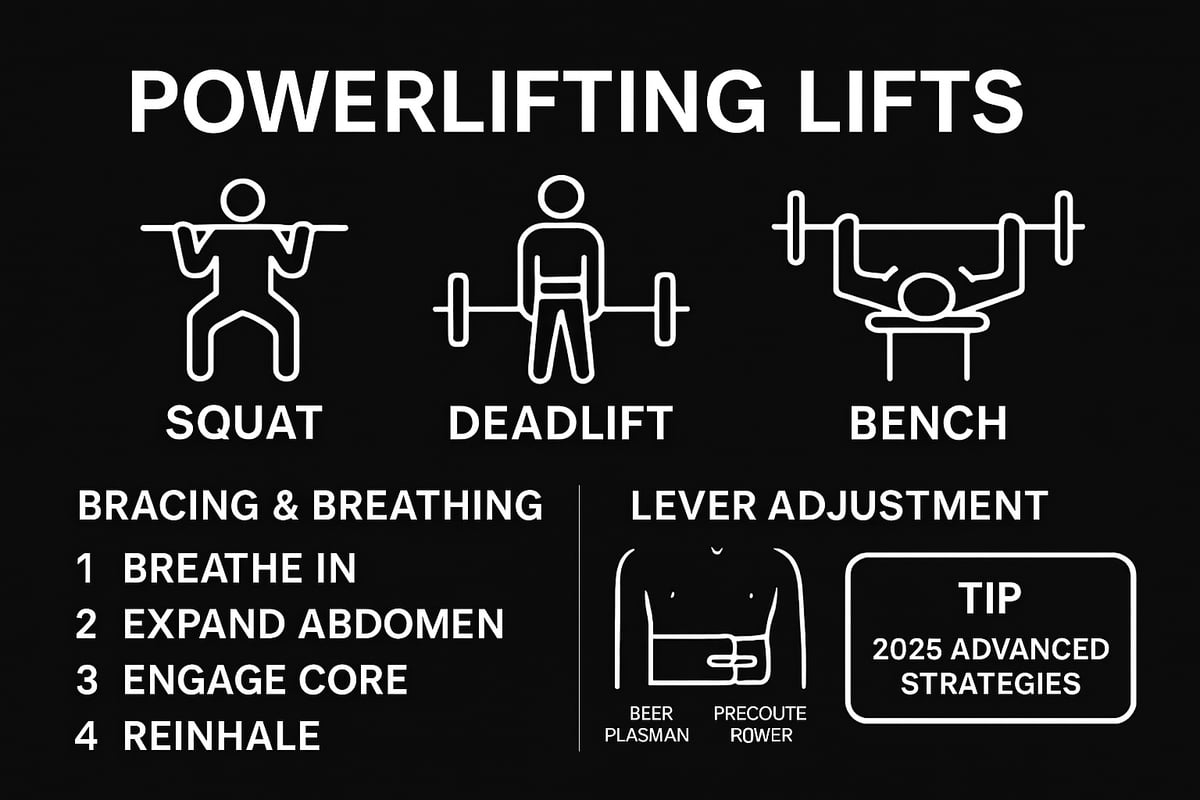
Proper Belt Use for Squat, Deadlift, and Bench
Using the sbd belt correctly in each main powerlift maximizes its benefits. For the squat, position the belt just above your navel, ensuring it covers the core muscles. This placement helps keep your torso upright and reduces lower back strain.
When deadlifting, the sbd belt should sit slightly lower, aligning with your hip bones. This setup prevents spinal rounding and supports a strong lockout. For bench press, some lifters use the belt to add core stability during heavy sets, though it is optional.
Quick Reference Table:
| Lift | Belt Position | Primary Benefit |
|---|---|---|
| Squat | Above navel | Upright torso, back support |
| Deadlift | At/above hips | Prevents rounding, lockout |
| Bench | Mid-core | Core stability (optional) |
Adjust the lever tension for each lift as needed. The sbd belt’s gliding lever makes these tweaks fast, so you can always find your perfect fit.
Breathing and Bracing Techniques
To get the most from your sbd belt, master bracing and breathing. Start with a deep diaphragmatic breath, filling your belly and pushing into the belt. Hold this pressure as you begin each rep. This technique increases intra-abdominal pressure and keeps your spine safe under load.
Practice bracing without a bar first, then add the sbd belt and feel how much more stable your core becomes. Many lifters report hitting personal records after refining this skill.
If you want an in-depth walkthrough, check out How to Use Lifting Belts for step-by-step guidance on proper technique and maximizing belt support.
When to Wear the Belt in Training
Knowing when to use your sbd belt is just as important as knowing how. Reserve the belt for your heaviest sets, maximal lifts, and competition practice. This approach helps you develop natural core strength during lighter work, avoiding over-reliance on the sbd belt.
For warm-ups and hypertrophy sets, train beltless. When shifting to heavier loads, introduce the sbd belt gradually. This method lets your body adapt and ensures you use the belt only when it truly counts.
Many advanced lifters cycle their sbd belt use, focusing on technique over numbers in the off-season, then ramping up belt use as meets approach.
Advanced Tips for 2025
In 2025, athletes are using the sbd belt in new ways. The gliding lever allows for quick adjustments between exercises or even between sets. For example, tighten the belt for a squat single, then loosen slightly for a set of deadlifts.
Pair your sbd belt with other supportive gear like knee sleeves or wrist wraps for all-around protection. Insights from elite coaches suggest dialing in your belt placement and tension before every big lift to maintain consistency.
Stay ahead of the curve by experimenting with belt settings and gathering feedback from your own training. The sbd belt is versatile, and a personalized approach will help you break new records.
Maintenance, Care, and Longevity of Your SBD Belt
Caring for your sbd belt is essential if you want it to provide years of reliable support and performance. With proper maintenance, you can keep your belt looking sharp, functioning smoothly, and ready for every heavy lift.
Cleaning and Conditioning
Regular cleaning keeps your sbd belt in top shape. For the black leather exterior, use a small amount of black shoe polish every 1–3 months. Apply gently, then buff to a shiny finish with a soft cloth. This preserves the leather’s strength and appearance.
Spot-clean the red suede interior with a damp cloth if needed. Never soak the belt or use harsh chemicals, as this can damage both the leather and suede. For more detailed routines and expert tips, check out this SBD Belt Maintenance and Longevity guide.
- Wipe sweat and chalk after each session.
- Let the belt air dry before storing.
- Condition the leather if it starts to look dry.
A clean sbd belt not only looks professional but also maintains its support and longevity.
Storage and Handling
How you store and handle your sbd belt matters. Always store the belt flat or rolled loosely to help it retain its shape. Avoid cramming it into tight gym bags or folding sharply.
Keep the sbd belt away from direct sunlight and moisture to prevent fading and mildew. Avoid dropping or throwing the belt, as this can damage the buckle or lever.
- Store in a cool, dry place.
- Roll or lay flat after use.
- Keep away from heaters and windows.
Proper handling ensures your sbd belt stays competition-ready.
Troubleshooting and Repairs
Even with great care, your sbd belt may develop minor issues over time. Common troubleshooting points include:
| Issue | Solution |
|---|---|
| Lever misalignment | Adjust screws and re-secure |
| Leather creasing | Condition and avoid over-tightening |
| Buckle/lever wear | Contact SBD for replacement |
If you notice persistent problems, like a loose buckle or excessive creasing, reach out to SBD’s customer service. In 2025, many users praised their quick and helpful buckle replacement process.
Regularly check your sbd belt for loose screws or worn parts. Prompt repairs keep your belt safe and reliable.
Maximizing Belt Lifespan
To get the most from your sbd belt, rotate between two belts if you train frequently. This allows each belt time to recover between sessions and reduces overall wear.
Inspect your sbd belt often for early signs of damage, such as fraying or tears. Addressing small issues early helps prevent larger problems. Data from 2025 shows many lifters use the same sbd belt for years without losing support or comfort.
- Rotate belts for heavy and light days.
- Inspect stitching and levers monthly.
- Replace worn parts promptly.
With these habits, your sbd belt can deliver consistent support for countless training cycles.
SBD Belt Updates and Trends for Powerlifting in 2025
Staying ahead in powerlifting means knowing what’s new with your gear. The sbd belt continues to be at the heart of strength training, especially as 2025 brings fresh innovations and community-driven trends. Let’s break down what’s changing and how you can make the most of the latest updates.
Latest Product Innovations
The sbd belt keeps evolving. In 2025, lifters see new limited edition colorways like Forge Grey and Orange, alongside the classic black and red. The lever mechanism now features smoother gliding and enhanced adjustability, making quick changes between lifts easier than ever.
SBD has collaborated with top athletes to refine both materials and design. Some belts now include subtle material improvements for increased durability and comfort. For a comprehensive look at all the latest releases, check out SBD Belt Updates and Trends 2025.
Powerlifting Rule Changes and IPF Compliance
Powerlifting federations, especially the IPF, updated their regulations for 2025. The sbd belt remains fully compliant, meeting the maximum thickness (13mm) and width (10cm) specs. Approved colorways and logo placements ensure your belt is competition-ready.
These changes are designed to create a level playing field. SBD’s commitment to compliance means you can trust your gear to pass equipment checks at any meet. Always double-check your belt’s colors if you plan to compete in international events.
Community and Athlete Feedback
Customer reviews in 2025 continue to praise the sbd belt for its unmatched support and quality. Lifters highlight the “exquisite quality” and note how recent updates make the lever even easier to use. Many athletes report hitting new PRs after upgrading to the latest model.
Trends show a growing interest in custom sizing and unique color options. Competitive lifters especially appreciate the consistent fit and the longevity of the belt, often mentioning years of reliable use with no dip in performance.
Accessories and Complementary Gear
Building out your powerlifting kit means pairing your sbd belt with other supportive gear. Many athletes now combine their belt with knee sleeves, wrist wraps, and lifting straps for comprehensive stability. If you’re looking to upgrade your accessories, read about Good Wrist Straps for Lifting to round out your setup.
This holistic approach not only boosts safety but also helps maximize your lifting potential in every session. As the sport evolves, so does the demand for high-quality, matching accessories.
Frequently Asked Questions About SBD Belts
If you are considering an sbd belt for your training in 2025, you probably have some questions about breaking in, sizing, versatility, and care. Here are the most common FAQs to help you get the most from your sbd belt.
How long does it take to break in an SBD belt?
Most lifters find the sbd belt starts to soften after 2 to 4 weeks of regular use. The high-quality leather will mold to your body faster if you use it during every heavy session. Avoid trying to speed up the process with oils or excessive bending.
Can I use the SBD belt for CrossFit or Olympic lifting?
The sbd belt is designed for powerlifting, with a 13mm thickness and 10cm width. While you can use it for heavy squats or pulls in CrossFit, it may be too stiff for Olympic lifts or dynamic movements. Many athletes prefer a thinner, more flexible belt for those sports.
What’s the difference between the SBD 13mm and thinner belts?
The 13mm sbd belt offers maximum stability and support, ideal for competitive powerlifters. Thinner belts are easier to break in and more comfortable for beginners or those who want greater mobility. Always match belt thickness to your training needs and comfort level.
How do I adjust the lever for multiple users?
You can re-position the lever by unscrewing it and moving it to a different hole. This allows for quick size changes if you share the sbd belt, but frequent adjustments may wear out the holes over time. For gyms, consider having multiple belts in different sizes.
Are SBD belts worth the investment for recreational lifters?
Absolutely. Even if you do not compete, the durability, consistent support, and adjustability of an sbd belt can help you train safer and lift heavier. Many recreational lifters say it is the last belt they ever need to buy.
What should I do if my belt doesn’t fit as expected?
First, double-check your waist measurement and compare it to the SBD size guide. If you are between sizes or plan to layer clothing, sizing up is often better. Contact SBD customer service for exchange options if you purchased the wrong size.
How do I care for my SBD belt to maximize its lifespan?
Wipe the belt after workouts, use black shoe polish every few months, and store it flat or rolled loosely. Spot clean the red suede interior as needed. To further protect your gear, consider pairing it with accessories like wrist wraps or deadlift straps recommendations for extra support and longevity.
Now that you know exactly what makes an SBD belt stand out and how it can take your powerlifting game to the next level in 2025, why not build a setup that fits your unique style and goals? At Katamu, we’ve got premium lever belts with eye catching designs and durability that lasts for years—plus all the accessories you need for serious training. Whether you’re chasing new PRs or just want to lift safer and smarter, you deserve gear that supports your journey. Ready to put together your own powerlifting kit?
Build your setup
